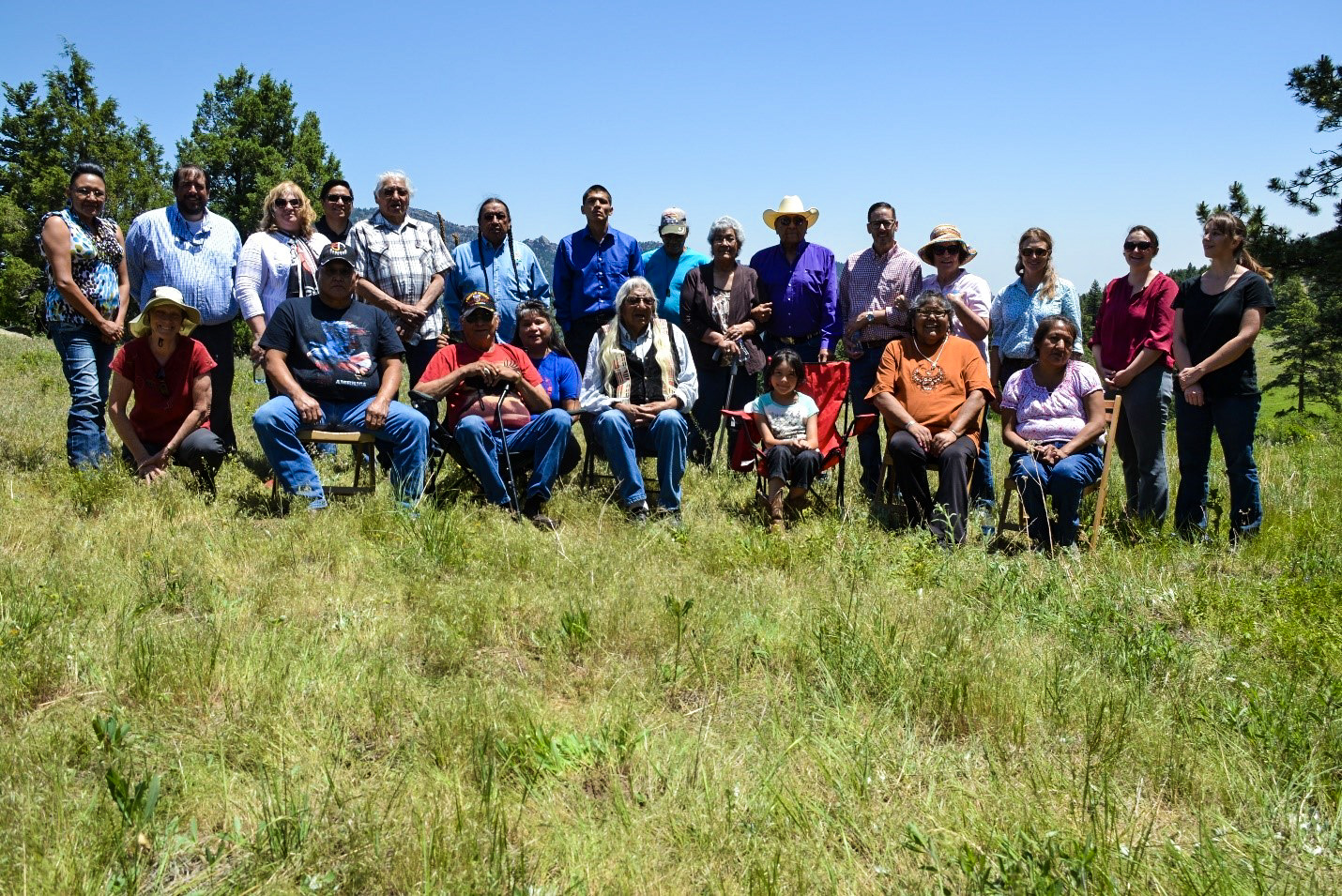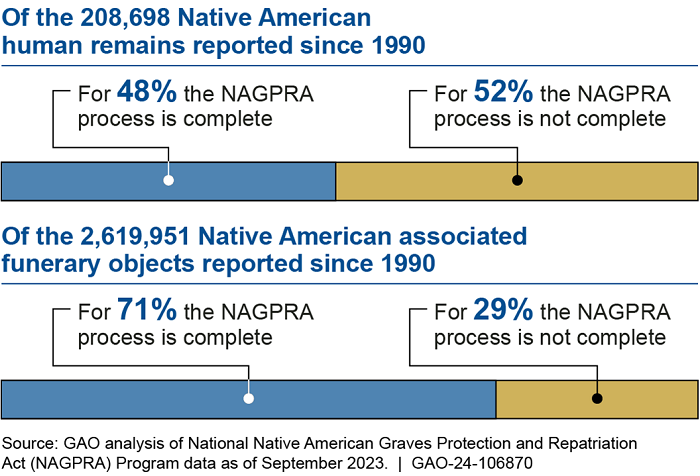Indianz.Com > News > Report confirms slow progress on repatriation of ancestors and sacred items

Report confirms slow progress on repatriation of ancestors and sacred items
Tuesday, October 10, 2023
Indianz.Com
It’s been more than 30 years since the passage of the Native American Graves Protection and Repatriation Act (NAGPRA) but federal agencies and museums are still far behind in returning ancestral remains and cultural property to their rightful places.
A snapshot report released by the Government Accountability Office (GAO) on Tuesday shows just how NAGPRA’s promises to Native peoples are going unfulfilled. Since 1990, fewer than half of the 208,698 ancestral remains being held by agencies and museums have gone through the complete NAGPRA process, according to official data.
And when it comes to the 2,619,951 sacred items being held by agencies and museums, the record is better — but the GAO identifies ongoing “challenges” in complying with NAGPRA. According to the report, issued a day after President Joe Biden declared Indigenous Peoples’ Day, nearly a third of funerary objects haven’t gone through the complete process.
“The program’s 2022 report notes that these agencies and museums have not completed the NAGPRA regulatory process for 52 percent of human remains and 29 percent of associated funerary objects,” the GAO report states.
“Until the process is complete, the items are not available for repatriation,” the report adds, confirming that American Indians, Alaska Natives and Native Hawaiians are still being denied their ancestral and cultural heritages, some 33 years after NAGPRA’s passage in 1990.
To help improve compliance with NAGPRA, GAO recommends federal agencies strengthen their tribal consultation policies. The report refers to “concerns” raised by lineal descendants, tribes and Native Hawaiian organizations. “Failure to consult with tribes, or to consult effectively, may result in irrevocable damage to cultural resources,” the GAO states. The report also states that the U.S. government isn’t doing enough to address the illegal removal of cultural items from federal and tribal lands. According to the GAO, “resource constraints, competing priorities, and limitations with data to support decision-making have hampered agencies’ efforts to prevent, investigate, and prosecute incidents of theft and damage.” Congress has taken additional action to protect tribes with the passage of the Safeguard Tribal Objects of Patrimony Act, also known as the STOP Act. The GAO report notes that the Department of the Interior has started developing regulations to implement the new law, an effort that began just a few months ago. The GAO also points out that Interior has yet to finalize new NAGPRA regulations that are supposed to streamline the repatriation of items held by federal agencies and museums. The work began more than two years ago, in the fall of 2021, and the proposed revisions were released almost a year ago.Native American Priorities: Protection and Repatriation of Human Remains and Other Cultural Items https://t.co/mQnJNNLEbU
— U.S. GAO (@USGAO) October 10, 2023

Finally, the GAO said the sale of tribal items in overseas markets remains an ongoing challenge. Implementing outstanding recommendations from prior NAGPRA reports in 2010, 2018, 2019 and 2021 could help address the issue, according to the report. “Implementing the remaining eight could help Interior target efforts to analyze and address risks to Native American cultural resources and improve how federal agencies communicate with tribes that request assistance with repatriating cultural items from overseas auctions,” the GAO said, noting that 47 other NAGPRA recommendations have been “fully implemented” as of September 2023. “This could also improve agencies’ efforts to consult with tribes on certain federal efforts that could affect cultural resources,” the report continued. The 2010, 2018, 2019 and 2021 NAGPRA reports were followed by Congressional testimony in February 2022, when the GAO discussed the challenges facing federal agency compliance with the law. The leader of the Senate Committee on Indian Affairs said it was clear that the work was far from complete. “While progress is certainly being made, the journey continues for tens of thousands of ancestors and millions of cultural items to find their way home,” said Sen. Brian Schatz (D-Hawaii), the chair of the legislative committee, noting that Congress originally thought it would take 10 years to repatriate ancestors and items held by agencies and museums. “And the promise of NAGPRA continues,” said Schatz.
Related Stories
Search
Filed Under
Tags
More Headlines
Native America Calling: A sample of Native Guitars Tour 2024
Native America Calling: How Native literature is changing the mainstream narrative
Native America Calling: No ordinary animal
Native America Calling: Safeguards on Artificial Intelligence
NAFOA: 5 Things You Need to Know this Week
Chuck Hoskin: Cherokee Nation takes the lead for our environment
Native America Calling: Earth Day assessment for Native peoples
Cronkite News: Gathering addresses ‘epidemic’ among Native people
VIDEO: Cody Desautel on tribes and federal forest management
AUDIO: Legislative Hearing on Discussion Draft of Forest Management Bill
Native America Calling: Remembering the 1974 Navajo border town murders
Native America Calling: Can the right approach close the Native immunization gap?
Cronkite News: Long COVID cases remain high in Arizona
Native America Calling: Eyes in the sky for development, public safety, and recreation
Native America Calling: Three new films offer diverse views of Native life
More Headlines
Native America Calling: How Native literature is changing the mainstream narrative
Native America Calling: No ordinary animal
Native America Calling: Safeguards on Artificial Intelligence
NAFOA: 5 Things You Need to Know this Week
Chuck Hoskin: Cherokee Nation takes the lead for our environment
Native America Calling: Earth Day assessment for Native peoples
Cronkite News: Gathering addresses ‘epidemic’ among Native people
VIDEO: Cody Desautel on tribes and federal forest management
AUDIO: Legislative Hearing on Discussion Draft of Forest Management Bill
Native America Calling: Remembering the 1974 Navajo border town murders
Native America Calling: Can the right approach close the Native immunization gap?
Cronkite News: Long COVID cases remain high in Arizona
Native America Calling: Eyes in the sky for development, public safety, and recreation
Native America Calling: Three new films offer diverse views of Native life
More Headlines